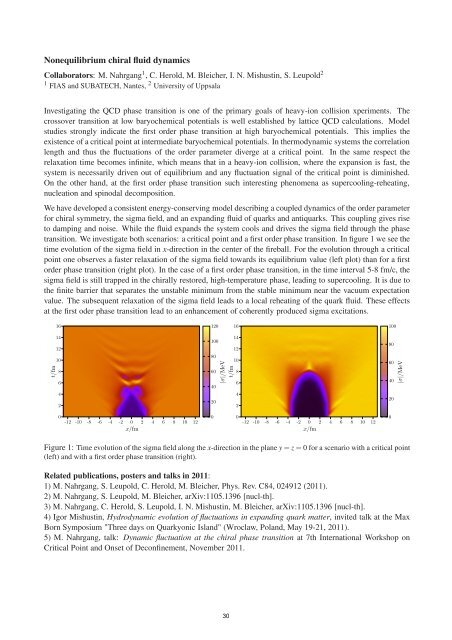FIAS Scientific Report 2011 - Frankfurt Institute for Advanced Studies ...
FIAS Scientific Report 2011 - Frankfurt Institute for Advanced Studies ...
FIAS Scientific Report 2011 - Frankfurt Institute for Advanced Studies ...
You also want an ePaper? Increase the reach of your titles
YUMPU automatically turns print PDFs into web optimized ePapers that Google loves.
Nonequilibrium chiral fluid dynamics<br />
Collaborators: M. Nahrgang 1 , C. Herold, M. Bleicher, I. N. Mishustin, S. Leupold 2<br />
1 <strong>FIAS</strong> and SUBATECH, Nantes, 2 University of Uppsala<br />
Investigating the QCD phase transition is one of the primary goals of heavy-ion collision xperiments. The<br />
crossover transition at low baryochemical potentials is well established by lattice QCD calculations. Model<br />
studies strongly indicate the first order phase transition at high baryochemical potentials. This implies the<br />
existence of a critical point at intermediate baryochemical potentials. In thermodynamic systems the correlation<br />
length and thus the fluctuations of the order parameter diverge at a critical point. In the same respect the<br />
relaxation time becomes infinite, which means that in a heavy-ion collision, where the expansion is fast, the<br />
system is necessarily driven out of equilibrium and any fluctuation signal of the critical point is diminished.<br />
On the other hand, at the first order phase transition such interesting phenomena as supercooling-reheating,<br />
nucleation and spinodal decomposition.<br />
We have developed a consistent energy-conserving model describing a coupled dynamics of the order parameter<br />
<strong>for</strong> chiral symmetry, the sigma field, and an expanding fluid of quarks and antiquarks. This coupling gives rise<br />
to damping and noise. While the fluid expands the system cools and drives the sigma field through the phase<br />
transition. We investigate both scenarios: a critical point and a first order phase transition. In figure 1 we see the<br />
time evolution of the sigma field in x-direction in the center of the fireball. For the evolution through a critical<br />
point one observes a faster relaxation of the sigma field towards its equilibrium value (left plot) than <strong>for</strong> a first<br />
order phase transition (right plot). In the case of a first order phase transition, in the time interval 5-8 fm/c, the<br />
sigma field is still trapped in the chirally restored, high-temperature phase, leading to supercooling. It is due to<br />
the finite barrier that separates the unstable minimum from the stable minimum near the vacuum expectation<br />
value. The subsequent relaxation of the sigma field leads to a local reheating of the quark fluid. These effects<br />
at the first oder phase transition lead to an enhancement of coherently produced sigma excitations.<br />
t/fm<br />
16<br />
14<br />
12<br />
10<br />
8<br />
6<br />
4<br />
2<br />
0<br />
-12 -10 -8 -6 -4 -2 0<br />
x/fm<br />
2 4 6 8 10 12<br />
120<br />
100<br />
80<br />
60<br />
40<br />
20<br />
0<br />
|σ|/MeV<br />
t/fm<br />
-12 -10 -8 -6 -4 -2 0<br />
x/fm<br />
2 4 6 8 10 12<br />
Figure 1: Time evolution of the sigma field along the x-direction in the plane y = z = 0 <strong>for</strong> a scenario with a critical point<br />
(left) and with a first order phase transition (right).<br />
Related publications, posters and talks in <strong>2011</strong>:<br />
1) M. Nahrgang, S. Leupold, C. Herold, M. Bleicher, Phys. Rev. C84, 024912 (<strong>2011</strong>).<br />
2) M. Nahrgang, S. Leupold, M. Bleicher, arXiv:1105.1396 [nucl-th].<br />
3) M. Nahrgang, C. Herold, S. Leupold, I. N. Mishustin, M. Bleicher, arXiv:1105.1396 [nucl-th].<br />
4) Igor Mishustin, Hydrodynamic evolution of fluctuations in expanding quark matter, invited talk at the Max<br />
Born Symposium "Three days on Quarkyonic Island" (Wroclaw, Poland, May 19-21, <strong>2011</strong>).<br />
5) M. Nahrgang, talk: Dynamic fluctuation at the chiral phase transition at 7th International Workshop on<br />
Critical Point and Onset of Deconfinement, November <strong>2011</strong>.<br />
30<br />
16<br />
14<br />
12<br />
10<br />
8<br />
6<br />
4<br />
2<br />
0<br />
100<br />
80<br />
60<br />
40<br />
20<br />
0<br />
|σ|/MeV
















